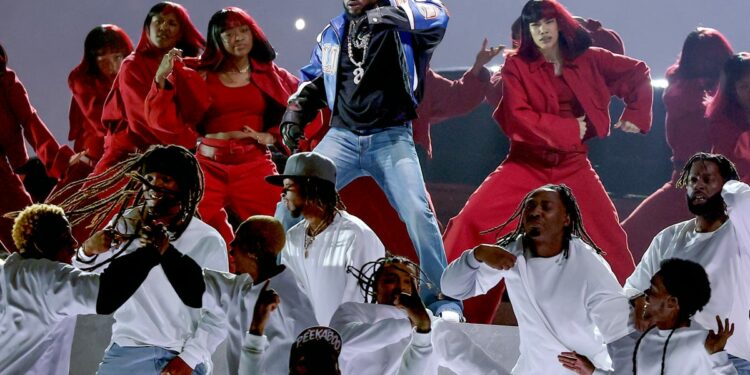Super Bowl halftime shows are typically moments of escapism, but Lamar refused to let America look away. We need to focus on creating inclusive and equitable measures that celebrate and protect all.
Kendrick Lamar teases his Super Bowl performance
Grammy award-winning artist Kendrick Lamar reveals what to expect from his upcoming Super Bowl halftime show.
Entertain This!
Kendrick Lamar’s Super Bowl halftime performance was a powerful commentary on race and inequality in America.Lamar’s use of imagery, such as the U.S. flag formed by Black dancers, highlighted the contributions and struggles of Black Americans throughout history.The performance also touched upon the broken promise of reparations and the need for systemic change to address racial disparities.
Since the Trump administration returned to the White House, the president has repealed civil rights protections and pushed harmful policies.
From the removal of diversity, equity and inclusion (DEI) protections through executive orders to Tennessee’s “anti-critical race theory (CRT)” laws that aim to remove the history of certain communities from schools, this country and its returning president are working hard to white-wash history.
That’s what makes rapper Kendrick Lamar’s Feb. 9 Super Bowl halftime performance more relevant than ever.
“This is the great American game!” As Samuel L. Jackson’s voice echoed around the Caesars Superdome in New Orleans, I knew this wasn’t going to be a regular Super Bowl performance. While halftime shows are typically about entertainment, Kendrick Lamar wasn’t taking the safe route.
From his 2016 Grammy performance calling out the prison industry to his 2018 set featuring Dave Chappelle’s chilling line “The only thing more frightening than watching a Black man be honest in America is being an honest Black man in America,” Lamar has always used his platform to push boundaries. His latest performance was no different.
This Super Bowl performance on the heels of his Grammy-award winning season was carefully curated to show America the one thing it’s afraid of, fully acknowledging its history. As expected, it drew backlash.
Kendrick Lamar sought to speak about Black Americans in U.S. history
His set design, a giant game controller, was a stroke of genius. For Black and Brown communities, life in America often feels like an unwinnable game. Make one wrong move or one misunderstood look, and the consequences can be life-altering. Samuel L. Jackson, who has long played “cultural narrator” roles in movies such as “Do The Right Thing,” reinforced this reality, echoing criticisms Black Americans hear constantly: “Too loud, too reckless, too ghetto.”
One of the most striking moments came when Lamar’s Black dancers formed the U.S. flag. The visual underscored an often-ignored truth: America’s rise to power was built on the backs of enslaved Black people and the genocide of Native communities. As civil rights activist Fannie Lou Hamer once said, “The flag is drenched with our blood.”
Then the flag split in half as he performed “HUMBLE.,” rapping, “It’s levels to it, you and I know.” The imagery reflected the inner conflict many Black Americans feel about patriotism.
While we seek pride in our country, the same flag has been wielded by terrorist groups like the Ku Klux Klan to instill fear. In turn, making it difficult for many to embrace. Loving a country that doesn’t always love you back is a layered struggle.
Lamar also referenced one of America’s broken promises: “40 acres and a mule, this is bigger than the music.” After the Civil War, formerly enslaved Black Americans were promised land − a promise that was quickly overturned after President Abraham Lincoln’s assassination in 1865.
The land was returned to former enslavers, setting the stage for centuries of systemic economic disparity.
Performance opens the door to discussion of reparations anew
Today, Black leaders like U.S. Rep. Ayanna Pressley, D-Massachusetts, continue to push for reparations.
“The racial wealth gap in America is not an accident,” she said. “It’s the direct result of generations of intentional policy harm—from Jim Crow to redlining to mass incarceration.” If the Homestead Act of 1862 could grant white Americans 160 acres of free government land, then surely 40 acres isn’t an unreasonable debt.
Critics call reparations a “handout,” but it’s actually overdue back pay for generations of forced labor. My ancestors built cities, fought in wars, and contributed immeasurably to the nation’s prosperity. The absolute least they deserve is the payment this country promised them 160 years ago.
One of the less-discussed moments of Lamar’s performance was his reference to revolution. Gil Scott-Heron famously said, “The revolution will not be televised,” emphasizing the need for a shift in mindset before real change can occur. Lamar flipped the phrase: “The revolution will be televised. You picked the right time but the wrong guy.” He made it clear: he isn’t here just to entertain; he’s here to challenge and educate.
Ending with “TV OFF” drove the message home.
Super Bowl halftime shows are typically moments of escapism, but Lamar refused to let America look away. If we truly want to ensure the longevity of our country, we need to focus on creating inclusive and equitable measures that celebrate and protect all.
Dave Chappelle summed it up perfectly after Kendrick Lamar’s performance at the 2018 Grammy Awards: “It looks like he’s singing and dancing, but this Black man’s taking enormous chances.”
Gabrielle Chenault covers Williamson County for The Tennessean. She received a bachelor’s degree in journalism with a minor in political science from Hampton University and a master’s degree in race/social justice reporting from the University of Southern California.
Source link : http://www.bing.com/news/apiclick.aspx?ref=FexRss&aid=&tid=67b872a069a74fa6a3bb628957a02e5a&url=https%3A%2F%2Fwww.usatoday.com%2Fstory%2Fopinion%2Fcontributors%2F2025%2F02%2F21%2Fkendrick-lamar-super-bowl-show-american-history-racism%2F79075029007%2F&c=8769378318189285482&mkt=en-us
Author :
Publish date : 2025-02-20 21:03:00
Copyright for syndicated content belongs to the linked Source.









